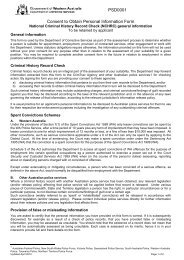Download - Health Sciences - Curtin University
Download - Health Sciences - Curtin University
Download - Health Sciences - Curtin University
You also want an ePaper? Increase the reach of your titles
YUMPU automatically turns print PDFs into web optimized ePapers that Google loves.
The assignment (approximately 4000-5000 words) consists of four parts.i. Drawing on relevant literature, define the disorder and briefly describepredisposing, precipitating, and protective factors. Include information onpsychopharmacology for this disorder.ii. Discuss how you might approach the treatment of a client presenting with thisdisorder. Review relevant research and clinical literature to substantiate thereasons for your approach.iii. Discuss any adaptation to psychotherapy processes that may be necessary tofacilitate the efficacy of therapy with a client who presents predominantly with thisparticular disorder. Such suggested adaptations may include therapy processes,your own assumptions, your own internal responses, and the therapeutic frame orsetting. If you have seen a client with this disorder, you may incorporate some ofyour clinical experiences to illustrate your discussion.iv. Append a 2- page summary of your findings about the disorder to the end of yourassignment. Write this with headings that other students/clinicians will find helpfuland can easily follow if they were to see a client with this disorder. Thesesummaries will be distributed to the whole group. Each student will do a twentyminutepresentation to the group summarizing the disorder and treatmentimplications.3. Assignment 3: Case Formulationi. Part 1 (No more than 3 pages) Utilizing a client from your placement or work, present afull case formulation. This should follow the case formulation presented in this unit andshould include DSM-IV/ICD-10 diagnoses. Ensure you present a brief treatment plan atthe end of the case formulation, using cited research literature on this particular disorder.ii. Part 2 (approximately 10 pages) Then, focus on one of the following advancedpsychotherapy processes: therapeutic alliance, empathic attunement, ruptures in thetherapeutic alliance, transference, countertransference, projection, defenses. Define anddiscuss the therapeutic process with reference to the relevant clinical and researchliterature.a. Discuss how this process manifested itself in the therapy, how you dealt with it,and the impact on treatment. Give examples of this process in your discussion.Wherever possible, use actual excerpts from 1 or 2 sessions to illustrate theprocess at work.b. Describe what, if anything, you would do differently with this client, in light of youranalysis of the therapeutic process which occurred and its impact on the client.Required readings from:American Psychiatric Association (1994). Diagnostic and statistical manual of mental disorders(4thedition). Washington: American Psychiatric Association.Barlow, D.H. (2008). Clinical handbook of psychological disorders (4th edition). New York: GuilfordPress.Bateman, A., & Fonagy, P. (2004). Psychotherapy for borderline personality disorder: Mentalizationbasedtreatment. Oxford: Oxford <strong>University</strong> Press.Beck, J.S. Cognitive therapy: Basics and beyond (1995). New York: Guilford Press.Beck, A.T., Freeman, A. Davis, D. (2004). Cognitive therapy of personality disorders (4 th Edition).New York: Guilford Press.Commonwealth of Australia (2002). National practice standards for the mental health workforce.Canberra: Commonwealth of Australia.Dimaggio, G., Semerai, A., Carcione, A., Nicolo, G., &Proacci, M. (2007). Psychotherapy of personality disorders: Metacognition, states of mind andinterpersonal cycles. London: Routledge.52<strong>Curtin</strong> <strong>University</strong> is a trademark of <strong>Curtin</strong> <strong>University</strong> of Technology.CRICOS Provider Code 00301J (WA), 02637B (NSW)





![Mental health commission report July 2010 - June 2011 [.pdf]](https://img.yumpu.com/50755705/1/184x260/mental-health-commission-report-july-2010-june-2011-pdf.jpg?quality=85)











![2007 Annual Report [.pdf] - Health Sciences - Curtin University](https://img.yumpu.com/44476724/1/184x260/2007-annual-report-pdf-health-sciences-curtin-university.jpg?quality=85)